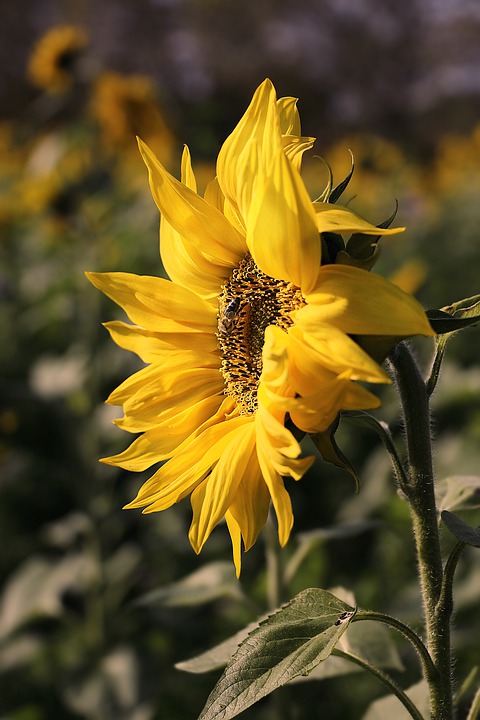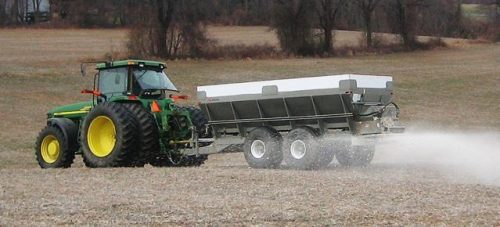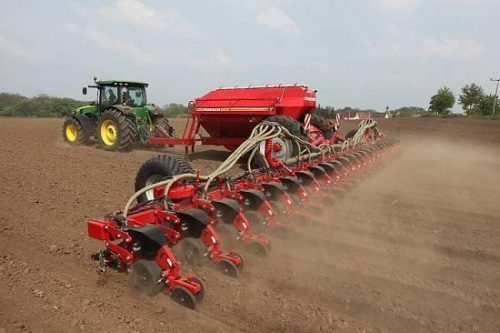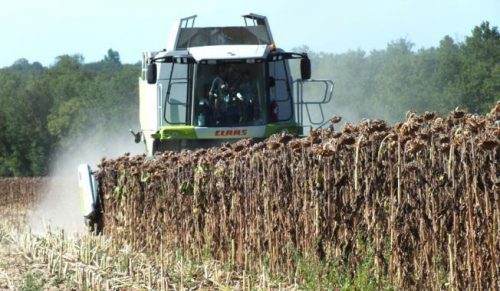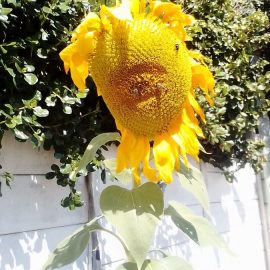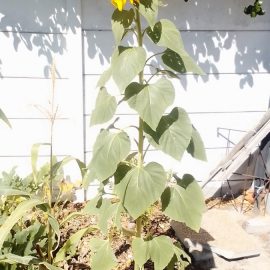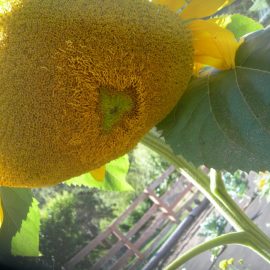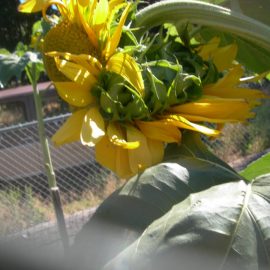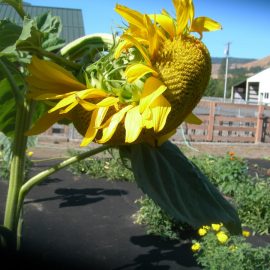Sunflower, cultivation and harvesting technology

The sunflower (Helianthus annuus) is one of the most important oil plants grown on Earth. Sunflower oil accounts for 13% of world oil production. The extraction is done through pressing and the normal extraction yield is around 45%. Sunflower press cakes have a high protein content (45-55%), representing a valuable animal feed. The capitulum (what is left from inflorescence) can also be used in animal feed. The stem is rich in potassium, is used to produce potassium carbonate. Sunflower is an excellent melliferous plant.
It has a pivot root. This allows the plant to explore the depths of the soil when there is no hardpan (a waterproof soil layer). The sunflower stem develops at the beginning of the vegetative growth period, then faster until it blooms, after which it stops growing. It is covered with short, rough hairs, and inside it has a medullary tissue that can store water. The leaves are arranged alternately, are cordiform, with serrated edges, covered with hairs, well developed. The inflorescence is a capitulum, protected by modified leaves. It has a row of ligulate flowers on the outside and many fertile hermaphrodite tubular flowers on the inside. The fruit is an achene of different colors. The sunflower has high requirements in terms of light, it prefers deep soils without hardpan, it consumes a lot of water (650 mm) and needs about 18-20° C during flowering.
Sunflower crop technology
Crop rotation
The sunflower is not very demanding regarding the preceding plant. Good results are obtained after crops with early harvest (autumn straw cereals, autumn wheat), corn, or peas. Due to common diseases, soybeans, beans, rapeseed should be avoided as precursors for sunflowers. Monoculture is excluded because of diseases, but also because of the frequent invasion of the crop with broomrape. The sunflower can be recultivated in the same field after at least 6 years.
Fertilization
The absorption of nutrients is fast during the first stages of vegetative growth. Over 66% of the nutrients are absorbed in the first 2 months. Sunflower cannot compensate for nutrient deficiencies during the early stages of growth. If it is not well supplied with nutrients in the first 3-5 weeks, the plant forms a few flowers and the production remains small, even if fertilizers are applied later. It is recommended to apply NPK complex fertilizers when preparing the seedbed. During the vegetative growth period, it is recommended to apply foliar fertilizers, water-soluble, or growth bio stimulators.
Recommended products
-
You can find products on a different store
Change Store -
You can find products on a different store
Change Store -
You can find products on a different store
Change Store -
You can find products on a different store
Change Store -
You can find products on a different store
Change Store -
You can find products on a different store
Change Store -
You can find products on a different store
Change Store -
You can find products on a different store
Change Store -
You can find products on a different store
Change Store -
You can find products on a different store
Change Store -
You can find products on a different store
Change Store -
You can find products on a different store
Change Store -
You can find products on a different store
Change Store -
You can find products on a different store
Change Store -
You can find products on a different store
Change Store -
You can find products on a different store
Change Store -
You can find products on a different store
Change Store -
You can find products on a different store
Change Store -
You can find products on a different store
Change Store -
You can find products on a different store
Change Store -
You can find products on a different store
Change Store -
You can find products on a different store
Change Store -
You can find products on a different store
Change Store -
You can find products on a different store
Change Store
Field works
The sunflower needs well-loosened soil, without a hardpan. The stubble plowing should be done as early as possible, after harvesting the preceding plant. Plowing must be done at a depth of 22-25 cm. In the case of heavy soils, the scarification work can be performed at 60 cm. The preparation of the seedbed has to be done with complex aggregates to reduce the number of crossings and implicitly reduce the soil compaction. Excessive soil loosening and rummage that favors the loss of water from the soil should be avoided.
Seeds and sowing
The seed must have a minimum purity of 98% and a germination capacity of at least 95%. Large and homogeneous seeds have to be used to reduce losses. The zonation of the hybrids must be done according to the pedoclimatic factors. Seed treatment is recommended against diseases and pests. The sowing of the sunflower seeds begins when the soil reaches a minimum threshold of 7-8 degrees Celsius, and it has to be done at a depth of 5-7 cm. The sowing season normally begins on March 25 and ends on April 15. The optimum density has various values (45,000-60,000). This is established according to the culture technology and the pedoclimatic factors. The sowing depth is 5-7 cm, or 4-5 cm if the soil is moist and free of weeds. The distance between the rows is 70 cm for non-irrigated crops and 80 cm for irrigated ones. The quantity of seeds is 3.5-5.5 kg/ha.
Additional pollination of sunflower brings increases in production of 300-600 kg/ha. This can be achieved by placing 2 hives/ha, near the crops.
Diseases and pests
The main diseases that can occur in sunflower crops are downy mildew, white rot, brown spot, rust, grey mold, Alternaria infection. Among the pests, the most common are Eurasian sunflower moth, grey corn weevil, darkling beetle.
Weed control
Sunflower is very sensitive to weeds infestation until it develops 5 pairs of leaves. The following herbicides can be used to control sunflower weeds:
Recommended products
-
You can find products on a different store
Change Store -
You can find products on a different store
Change Store -
You can find products on a different store
Change Store -
You can find products on a different store
Change Store -
You can find products on a different store
Change Store -
You can find products on a different store
Change Store -
You can find products on a different store
Change Store -
You can find products on a different store
Change Store -
You can find products on a different store
Change Store -
You can find products on a different store
Change Store -
You can find products on a different store
Change Store -
You can find products on a different store
Change Store -
You can find products on a different store
Change Store -
You can find products on a different store
Change Store -
You can find products on a different store
Change Store -
You can find products on a different store
Change Store -
You can find products on a different store
Change Store -
You can find products on a different store
Change Store -
You can find products on a different store
Change Store -
You can find products on a different store
Change Store -
You can find products on a different store
Change Store -
You can find products on a different store
Change Store -
You can find products on a different store
Change Store -
You can find products on a different store
Change Store
Irrigation
The water requirements of sunflower are similar to that of corn. The maximum sensitiveness stage starts from the bud stage and lasts until the end of flowering. The lack of water during flowering decreases the number of seeds on the capitulum, and if there is drought during the seed development, the oil content decreases. Irrigation can be done through spraying, by watering 2-3 times (400-800 cubic meters/ha/watering), at an interval of 7-14 days.
Harvesting
It can be considered that the plants reached the maturity when 80-85% of the flower heads are brown. The harvest period is between August 20 and September 15. Harvesting is done mechanically when the humidity of the achenes is 15% and it is recommended to be completed when they have a humidity of 9-10%. Harvesting too early leads to drying costs and crop depreciation. Also, harvesting too late can lead to production losses (even 1 t/ha).














































































































































































































































































































































































































































